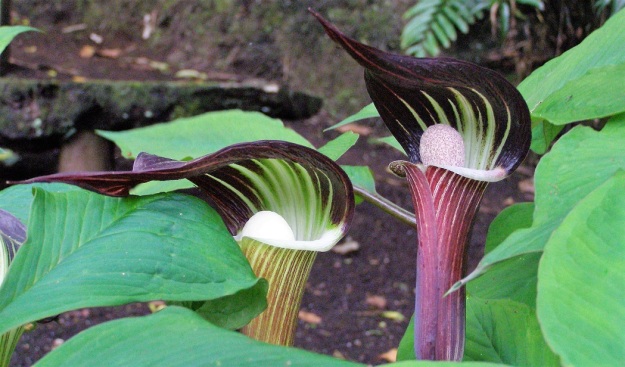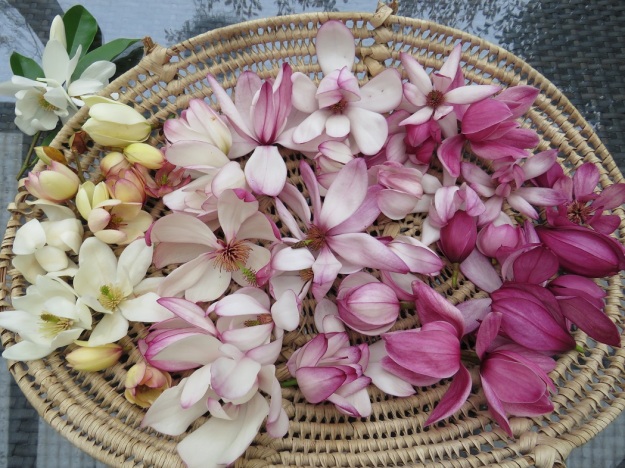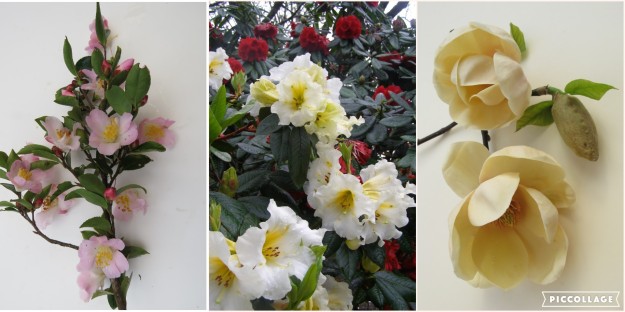* as told to The NZ Rhododendron, the annual journal of NZRA Council and Pukeiti Trust Boad. December 2017. Photos are mine.

Mark could perhaps be described as having chlorophyll running in his veins. He was the afterthought child in his family, quite a bit younger than his brothers. He remembers tagging along with his parents and visitors, listening in as they discussed plants around the Tikorangi garden in North Taranaki. “It was quite a lonely and isolated life in the country and I really wanted the social contact, even if it was with older people. It was only later that I realised what I learned in those early years.”
Mark was determined to head off to university, the first in his farming family to do so. It was not an easy path but he graduated with Bachelor’s degree in Social Sciences, majoring in Psychology. He enrolled in a post-graduate diploma in guidance and counselling but withdrew half way through the year. “I was the youngest on the course and all the others were teachers with regrets. One would have liked to be a potter, another dreamed of running a country pub. I didn’t want to get to my late 40s and look back with regret. By that stage, Abbie and I had already been married a couple of years and I went home and told her I wanted to withdraw from the course and follow some dreams.”
From there, he taught himself to draw from a book by John Ruskin, taught himself to turn wood to a high quality and then set out to learn how to propagate and, from there, to build a nursery.
“When I started here, there was no nursery. Dad was a just a farmer and a gardener who liked to breed plants. He had taught himself the rudiments of propagation. I started to build the nursery from one wheelbarrow up and I set out to learn how to propagate and to grow plants commercially. It was a case of learning through trial and error. It has always surprised me how successful the nursery was.” Mark credits the access to his father’s plant hybrids for giving him new material to mark out his nursery as different to the rest. “Dad had pretty much stopped hybridising by then. It was only ever a hobby for him. I started more systematically to see how far I could push plant breeding. And as the plant breeding grew in range and scale, I had the nursery to cope with growing on the material.” He started with saturation coverage of a large plant of Camellia pitardii in a Urenui garden.
From an early stage, Felix made it clear that the garden he and his wife Mimosa had built would pass to Mark and his family. Mark and Abbie are demonstrably aware of what it means to be on a family property that is already on its fourth generation.

Arisaema seedlings are for the garden at Tikorangi, not commercial release
Mark is clear in his mind about the hybridising he does which has commercial potential and that which is solely to try and get better plants for their own garden. He is currently working with galanthus, aiming for later flowering cultivars which perform as well in Tikorangi conditions as Galanthus nivalus ‘S. Arnott’. He is continuing the efforts of his late father with cyclamineus narcissi, looking for sterile selections that bloom from every bulb, as Felix Jury’s ‘Twilight’ does. In the hellebores, improving garden performance and getting cultivars which hold their blooms above the foliage are the aims, as well as looking for sterility if possible. In the arisaemas, he wanted to extend the colour range and the season and to get some hybrid vigour into A. sikokianum types. He is often to be found out and about with his magnifying glass and paintbrush.
The garden is always the star in Mark’s mind. “This is a poor man’s garden,” he says. “It was never made with a big budget and if we had to buy in all the plants we want, we could never afford to keep it going, let alone expand as we are. To get masses of snowdrops to the point where they naturalise themselves to or to get a new 40 metre of border of auratum lilies, we have to raise our own from seed. And when raising from seed, I often like to start with controlled crosses to see if I can get better outcomes, rather than just using open pollinated material.”
The garden is a treasure trove of plant material, some of which may or may not go into commercial production at some stage in the future but which currently has no market. “We have some thrip-resistant rhododendrons with full trusses if that plant genus comes back into fashion. At the moment, the market is so small that there is no commercial advantage in releasing them.” The same is true of coloured and variegated cordylines and a range of camellias.

Magnolia Felix Jury
The creation of new cultivars with international potential has been a major focus. In the deciduous magnolias, Mark has named and released four out of many hundreds that he has raised. But he says he has the next three possibles under trial. Of those released, the magnolia that he named for his father is his greatest pride. “It is what Felix was trying to get to – good colour in a large cup and saucer bloom, so I called it ‘Felix Jury’. This one is doing really well internationally which is particularly pleasing. It has already been given an award of garden merit from the RHS.”

A range of michelia seedling blooms

Fairy Magnolia White, with bonus kereru
The michelias are a source of frequent disappointment to Mark. “We have raised so many of them now and have a good range of new colours. But it is so difficult to get everything in one plant – clean colour, good size of bloom and plenty of them over an extended period, compact, bushy growth, easy to propagate and scented. Keeping the scent is the most elusive attribute of all.” Mark has named three so far, marketed under the ‘Fairy Magnolia’ brand, but there is a long way to go yet and he keeps persevering, often with several hundred new seedlings a year.

Camellia Fairy Blush, Rhododendron Floral Sun and Magnolia Honey Tulip
Amongst the camellias, Mark names his selection of ‘Fairy Blush’ as his personal favourite. He and Abbie have chosen to use it extensively for clipped hedging in their garden because of its long flowering season and its good habit of growth. ‘Floral Sun’ remains his pick amongst the rhododendrons.

Daphne Perfume Princess
Ironically, it is a daphne, a one-off plant from a speculative breeding effort, that may prove to be the most lucrative cultivar internationally. ‘Perfume Princess’ basically looks like an odora although it often flowers down the stem like bholua. It is the size of the flower, the vigour of the plant and the length of the flowering season that sets this plant apart from other daphnes. “It is just a brilliant plant to grow and a terrific nursery plant to produce,” Mark says. “That is not true of most daphnes which can be very difficult to produce in containers.” Both the local and international markets for a daphne eclipse the market for magnolias, even if the plant itself is less spectacular.
“We stopped doing mailorder in 2003, stopped wholesale in 2008 and phased out retail after that. The phone calls and emails in search of plants haven’t stopped in the time since but we were really glad to shut all that down. Abbie always described nursery work as being like factory work but in better surroundings. There was no fun in it but it enabled us to get to where we are today.” Mark is quietly proud of the fact that royalties on plant sales, particularly overseas, are what enabled them to retire from the nursery trade and pursue their interests in the garden.
The garden is still expanding. They closed to the public 3 years ago and have been enjoying the freedom to experiment. “We’ll open again at some stage, maybe 2019. For the annual garden festival, at least. Though we are unlikely to ever open again for extended periods during the year.”

Mark and the Magnolia Felix Jury tree at Wisley on the left. Mark with a collection of blooms from different seedlings at home in Tikorangi

I’m really impressed by this account of Mark’s achievements. I wish I had met him when I was growing up in Stratford, learning about plants, trees and flowers. What an excellent model and base his father provided. Lifetime achievements are built on stable circumstances like that. And the progress made is a life’s endeavour and passion of course – that’s so evident. Congratulations!
In New Zealand we are such a mobile population still, that stories like Mark’s that span generations and have that strong link to a particular place are nowhere near as common as many other countries. Glad you enjoyed his story.
Abbie honey I got TOTAL goosebumps from head to foot reading this! I have no words really to express how wonderful it is to know how much you both love Tikorangi and your plants. Mark, you are a TOTAL inspiration and I love that YOU love what you are doing re propagation/breeding etc so much. I left a job as a top flight PA back in 1993 to pursue my dream of working with plants – part-time in garden centres in Wellington at that stage. I knew it would be the demise of my first (and only other I promise!) marriage because of the drop in salary. I have never looked back and am so proud to have my perennial nursery. My favourite thing is to propagate from seed and I am constantly emitting a little ”shriek” when I see new, very special seedlings from my hardy cranesbill geranium collection.
Tikorangi is a VERY special garden and every mm of it exudes a love of plants and the natural environment. How special to be the fourth generation on that land.
Okay I’ll stop waffling now… just loved this so much! p.s. your Arisaemas are STUNNING.. I adore this genus of plants and have a few here in my garden.
Your joy and delight are infectious, Philippa! And your pleasure and skill in growing plants from seed is a skill that should be recognised in these days of deskilling.
So beautiful – love the story, and would love to visit one day when maybe you are open…
Loved this post, Abbie. Because I always love the human element. In fact best post of the year for me. Which is a fitting time to say, as we get real busy here from about now, it’s been great following your blog over the year, look forward to next year. All the best for the festive season to you and Mark.
Thank you, Mark. That is so very kind of you to say so (though I think post about hiring a rental car in Italy surpassed all others!) I have appreciated your comments and interest. I trust you have a fine festive season filled with laughs, good company and good cheer.
Considering the resricted conditions under which Mark has to work and the restricted plant material he has available, I am always stunned by the results of his crosses.
Everything comes out as a class act with exceptional features and of a quality that is best described as the ‘knock them all dead impact’ (it has to be, otherwise he wouldn’t have released it).
He is really an extraordinary man. You must be very proud.
What can I say, Andre? We are both feeling honoured by your accolade. Thank you.
We loved this post Abby. Fascinating to read some of Mark’s personal and family history in relation to plant breeding. We have been very impressed with Camellia ‘Fairy Blush’ and have a few of these plants growing in a short section of hedge. We are very pleased you plan to reopen Tikorangi for public visits again one day too. We visited your garden during the Taranaki Garden Festival in 2008 and felt it was one of the best we’d seen. And the Arisaema just blew us away: we’d never seen anything like them before or since. Next time we visited for the Festival was the first year you weren’t open and we were sad about that as it was one of the few on our ‘must see again’ list.
Thank you. That really was rewarding to read.